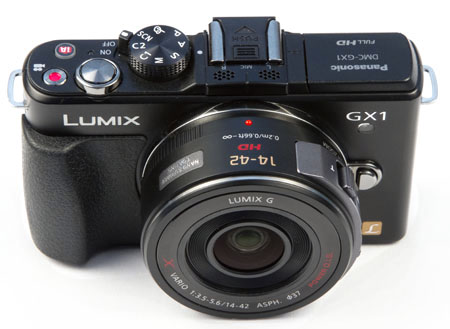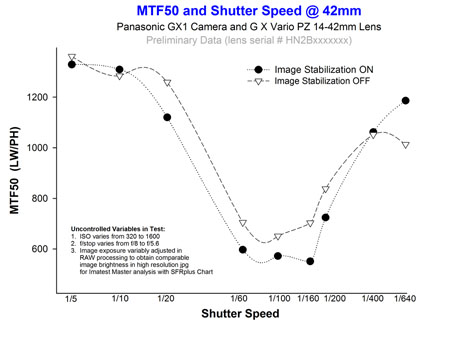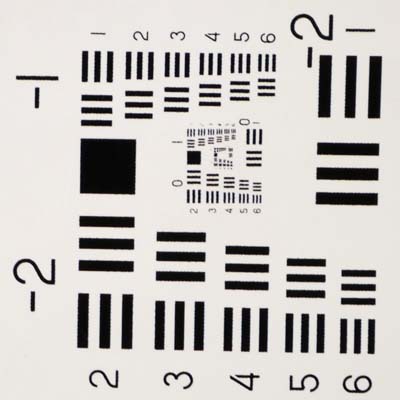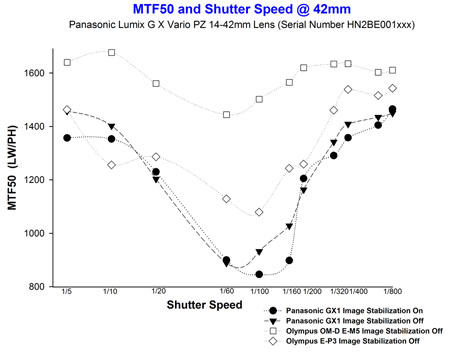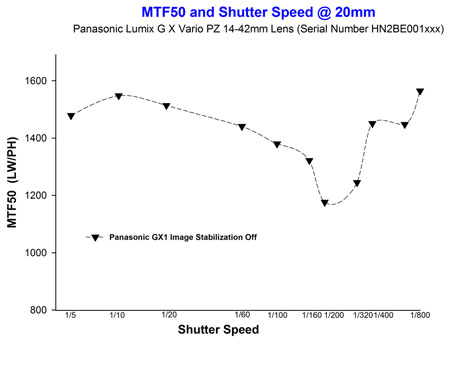Review: Panasonic Lumix G X Vario PZ 14-42mm f/3.5-5.6
The performance of the ultracompact 3X Panasonic Lumix G X Vario PZ 14-42mm zoom lens was compared with that of the Panasonic 14-45mm zoom lens and several prime lenses. The small size of the PZ 14-42mm zoom makes it very attractive as a lens to carry around with a small micro four thirds camera in a pocket or on your belt. It is reasonable to expect compromised performance in a super compact retractable pancake lens. I ran initial photographic tests with the lens and a Panasonic GX1 camera to evaluate it against my current favorite zoom (Panasonic 14-45mm f/3.5-5.6) and 28, 17, 20 and 45mm prime lenses. Three new X PZ 14-42mm lenses were tested in this review.. Details of the lenses as well as the tests run on shutter speed associated image blurring are HERE. Lens size, weight and cost data are here. The GX1 used in the test was purchased new in May, 2012.
MTF50 Results
MTF50 performance was determined using Imatest Master v. 3.7 as described using a SFRplus Chart. A 13 region, center-weighted value is posted below that includes analysis of corners. Central MTF50, chromatic aberration (CA), light drop off and distortion were also determined with Imatest, and data are tabulated HERE. Photographs showing limited distortion of the PZ 14-42mm lens are HERE
The PZ 14-42mm lens had significantly lower MTF50 performance than the 14-45mm zoom lens from wide open to f/8 at 17mm, 20mm and, most markedly, at 42mm.
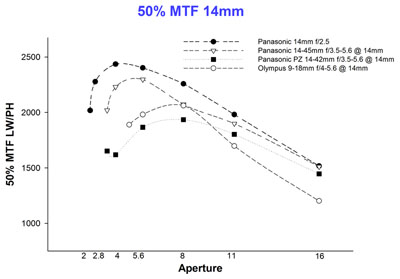 |
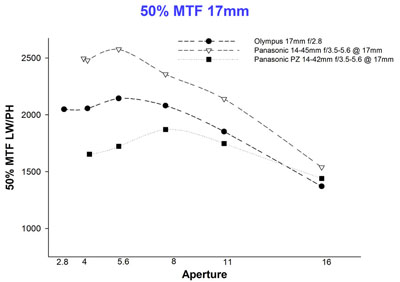 |
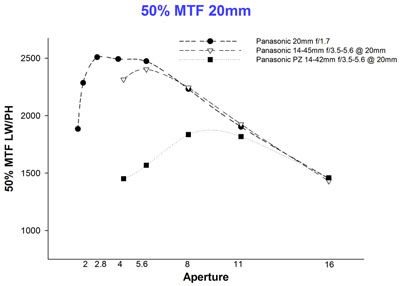 |
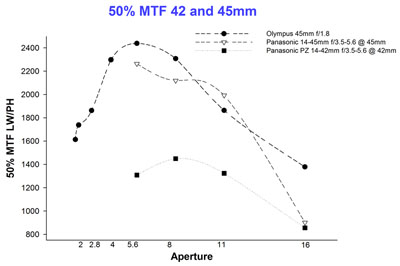 |
Light Drop Off (Vignetting)
The PZ 14-42mm lens performed comparably well to other lenses tested at 14mm. Greater vignetting was measured in the PZ 14-42mm at 20mm. Severe vignetting was measured in the PZ 14-42mm at 42mm.
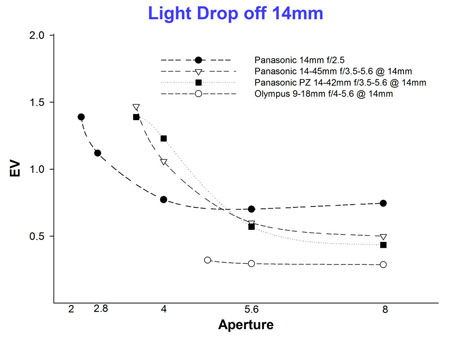 |
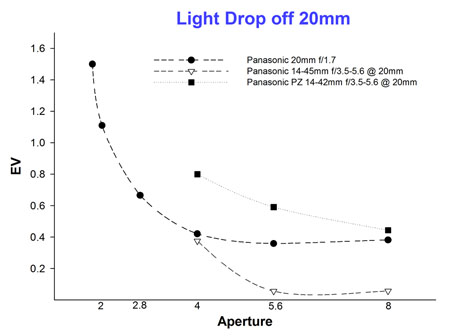 |
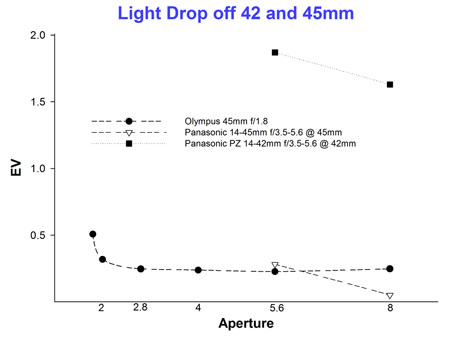 |
Parking Garage Photo Test
Are differences in MTF50 visible in photos?
Yes, slight differences in image quality are visible in images produced by the PZ 14-42mm lens at 20mm and especially at 42mm. The differences are visible in the web images and in the 12x16 inch print images (examine Center and Edge of high resolution files in the column below on the right.) The differences are relatively small, but are detectable in print sizes of 12x16 inches if examined closely. It is unlikely that differences would be detectable in smaller prints.
| 14mm Full Size Web Image Lenses tested: |
14mm Detail of 12x16 inch High Resolution Print File |
 |
Click for Center of Image Click for Edge of Image |
| 20mm Full Size Web Image Lenses tested: Panasonic 14mm f/2.8 - f/4 to f/8 Panasonic 14-45mm f/3.5-5.6 - f/4 to f/8 Panasonic PZ 14-42mm f/3.5-5.6 - f/4 to f/8 Olympus 9-18mm f/4-5.6 - f/5 to f/8 |
20mm Detail of 12x16 inch High Resolution Print File |
 |
Click for Center of Image Click for Edge of Image |
| 42mm Full Size Web Image
Lenses test: Panasonic 14-45mm f/3.5-5.6 - f/5.6 to f/8 Panasonic PZ 14-42mm f/3.5-5.6 - f/5.6 to f/8 |
42mm |
 |
Click for Center of Image Click for Edge of Image |
Shutter Speed and Image Sharpness
Previous user reports (e.g.,dpreview.com forums) have identified shutter speed associated blurring of images with with the X PZ 14-42mm lens and some cameras in the 1/100 to 1/200 shutter speed range. Several tests were run as outlined here.
Shutter-Speed Associated Degredation of Image Sharpness with the GX1
The Panasonic GX1 and X PZ 14-42 combination showed significant shutter-speed associated loss of image MTF50 that correlated with detectable decreases in sharpness of images at shutter speeds between 1/60 and 1/160. This appeared to be due to the level of shutter induced camera vibration associated with loud mechanical shutter action. The Olympus OM-D E-M5 has the quietest shutter on any micro four thirds camera that I have tested (i.e., GF1, GF2, G1, GX1, E-PL1, E-PL2, E-PL3, E-P3 and OM-D E-M5) and did not have as significant degredation of image quality when shutter speed was set in the 1/60 to 1/160 range compared to other cameras tested.
Two other lenses were tested with the GX1, E-P3 and the OM-D E-M5. Tests are on this Page.
The GX1 induced significant
shutter-speed associated decrease in MTF50 performance with both the Olympus 45mm f/1.8 and the Panasonic 14-45mm f/3.5-5.6 lenses. However, MTF50 did not drop below 1000 LW/PH, and this decrease in MTF50 was not associated with loss of image resolution that was readily detectable.
Summary of Findings:
The lens produced reasonably sharp images when stopped down to f/5.6 or f/8 in the zoom range from 14mm to 20mm. Performance at 42mm was problematic. Images were softest in tests at 42mm and had substantial vignetting at this focal length. In addition, in the shutter speed range from 1/60 to 1/160, some cameras such as the Panasonic GX1 and the Olympus E-P3 showed further significant decrease in MTF50 performance with this lens at 42mm.
Conclusions/ Opinion:
This review is written from the perspective of a photo enthusiast with an acquired preference for quality prime lenses and high performance zooms. The Panasonic Lumix G X Vario PZ 14-42mm zoom lens is an ultracompact 3X zoom lens that offers the promise that a small micro four thirds camera such as the GX1 will function with the portability and versatility of a compact camera while retaining excellent photographic function of a micro four thirds camera. This performance review demonstrates that the promise of small size and excellent function is only partially realized.
Compactness and light weight of the lens comes with associated trade offs in several areas of photographic performance. The X PZ 14-42mm lens has very good performance in the 14 to 20mm range. Photographic performance (i.e., sharpness and freedom from vignetting) is significantly compromised at 42mm. If you need the versatility of a 3X zoom in the 14-42mm range with high performance, there are better choices than the X PZ 14-42mm lens. The significanly larger Panasonic 14-45mm f/3.5-5.6 lens showed significanly better performance in these tests. Alternatively, several light weight prime lens can be carried for high performance in a highly portable, light weight kit.
Nevertheless, for many who want a highly portable, light weight lens with 3X zoom for micro four thirds camera and who will be either sharing low resolution images electronically or producing small prints ( 8x10, A4 or smaller), the Panasonic Lumix G X Vario PZ 14-42mm zoom lens will be all the lens they will need.
Index
posted 25 July 2012; Updated 26 July, 01 August and 03 August, 2012
© 2012, William L. Castleman
